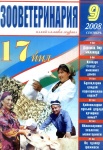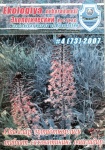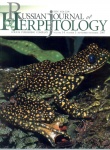Articles
The result of the study of feeding of the tortoise Agrionemys horsfieldii.
Authors: D. A. Bondarenko, E.A. Peregontsev.
Name: The result of the study of feeding of the tortoise Agrionemys horsfieldii. 2012, Zoological Journal, Vol. 91, No 11, p.1397-1410
Authors: D. A. Bondarenko, E.A. Peregontsev.
Name: The result of the study of feeding of the tortoise Agrionemys horsfieldii. 2012, Zoological Journal, Vol. 91, No 11, p.1397-1410
Ecological and geographical feeding peculiarities of the central asian tortoise (Agrionemys horsfieldii GRAY, 1844) in desert landscapes.
Authors: D.A. Bondarenko,E. A. Peregontsev,V.V. Neronov
Name: Ecological and geographical feeding peculiarities of the central asian tortoise (Agrionemys horsfieldii GRAY, 1844) in desert landscapes. 2011, Russian Journal of Herpetology Vol. 18, No. 3, 2011, pp. 175 – 184
Authors: D.A. Bondarenko,E. A. Peregontsev,V.V. Neronov
Name: Ecological and geographical feeding peculiarities of the central asian tortoise (Agrionemys horsfieldii GRAY, 1844) in desert landscapes. 2011, Russian Journal of Herpetology Vol. 18, No. 3, 2011, pp. 175 – 184
A long-term experience of rearing Agrionemys horsfieldii (Gray, 1844) in Uzbekistan.
Authors: Bykova E.V., Sorochinsky V.G., Sorochinsky G.Ya., Sorochinskaya E.N., Peregontsev E.A.
Name: Herpetological studies in Kazakhstan and adjoining states. Almaty, 2010. Collection of scientific articles. Almaty, ASBK-SOPK, 2010. - 260 pp. illustrated. P. 64-69.
Abstract: An artificial hatching and rearing – ranching of A. horsfieldii have been carried out for ten years at the farm of Tashkent Zoological complex. During tortoise maintenance at the conditions close to natural the different aspects of animal breeding biology were studied including oviposition frequency, size and weight of the eggs. In 2007, of 23740 eggs incubated 17738 tortoises have hatched. The size-weight characteristics of 8746 specimens were provided for eight months of maintenance. During five years, observations have been conducted for a group of animals hatched and reared in man-made conditions. It was confirmed that tortoises show much faster growth in captivity. At the age of five years, females laid eggs; however, no offspring was obtained from them.
Authors: Bykova E.V., Sorochinsky V.G., Sorochinsky G.Ya., Sorochinskaya E.N., Peregontsev E.A.
Name: Herpetological studies in Kazakhstan and adjoining states. Almaty, 2010. Collection of scientific articles. Almaty, ASBK-SOPK, 2010. - 260 pp. illustrated. P. 64-69.
Abstract: An artificial hatching and rearing – ranching of A. horsfieldii have been carried out for ten years at the farm of Tashkent Zoological complex. During tortoise maintenance at the conditions close to natural the different aspects of animal breeding biology were studied including oviposition frequency, size and weight of the eggs. In 2007, of 23740 eggs incubated 17738 tortoises have hatched. The size-weight characteristics of 8746 specimens were provided for eight months of maintenance. During five years, observations have been conducted for a group of animals hatched and reared in man-made conditions. It was confirmed that tortoises show much faster growth in captivity. At the age of five years, females laid eggs; however, no offspring was obtained from them.
On some aspects of a successful rearing of the Horsfield’s tortoise, Agrionemys horsfieldii Gray,1844
Authors: E.V. Bykova, V.G. Sorochinsky 1, G.Ya. Sorochinsky 1, I.N. Sorochinskaya 1, E.A. Peregontsev
Name: MODERN HERPETOLOGY. 2009. Vol. 9, issue 1/2. P. 3-11
View abstract
Authors: E.V. Bykova, V.G. Sorochinsky 1, G.Ya. Sorochinsky 1, I.N. Sorochinskaya 1, E.A. Peregontsev
Name: MODERN HERPETOLOGY. 2009. Vol. 9, issue 1/2. P. 3-11
View abstract
Polymorphism of gene 12S rRNA and phylogeography of the Horsfield’s tortoise, Agrionemys horsfieldii Gray, 1844
Authors: V.A. Vasiliev, D.A. Bondarenko, E.A. Peregontsev, A.S. Voronov, A.P. Ryskov, S.K. Semenova
Name: Genetics, 2008, vol. 44, No 6, p. 784-788
Abstract: The genetic variability of separate populations of the Horsfield’s tortoise Agrionemys horsfieldi gray1844, was for the first time studied in a significant part of the range covering Uzbekistan, southern Kazakhstan, northern and eastern Iran on the basis of the intraspecific polymorphism of the mitochondrial gene 12S rRNA. Four haplotypes, two of which (AN1 and AN2) had been described previously, were recorded in 59 tortoises. The haplotype AN1 was typical of 52 tortoises inhabiting the range of southern Kazakhstan and Uzbekistan. The haplotype AN2 was found in four tortoises from the border territory of Uzbekistan, Tajikistan and Afghanistan. Two new haplotypes AN3 and AN4 were found in three tortoises from Iran. A possible time of divergence between different parts of the range was calculated on the basis of nucleotide replacements of 12S rRNA. Possible ways of the formation of modern intraspecific groupings of the Horsfield’s tortoise A. horsfieldi were discussed.
View abstract
Authors: V.A. Vasiliev, D.A. Bondarenko, E.A. Peregontsev, A.S. Voronov, A.P. Ryskov, S.K. Semenova
Name: Genetics, 2008, vol. 44, No 6, p. 784-788
Abstract: The genetic variability of separate populations of the Horsfield’s tortoise Agrionemys horsfieldi gray1844, was for the first time studied in a significant part of the range covering Uzbekistan, southern Kazakhstan, northern and eastern Iran on the basis of the intraspecific polymorphism of the mitochondrial gene 12S rRNA. Four haplotypes, two of which (AN1 and AN2) had been described previously, were recorded in 59 tortoises. The haplotype AN1 was typical of 52 tortoises inhabiting the range of southern Kazakhstan and Uzbekistan. The haplotype AN2 was found in four tortoises from the border territory of Uzbekistan, Tajikistan and Afghanistan. Two new haplotypes AN3 and AN4 were found in three tortoises from Iran. A possible time of divergence between different parts of the range was calculated on the basis of nucleotide replacements of 12S rRNA. Possible ways of the formation of modern intraspecific groupings of the Horsfield’s tortoise A. horsfieldi were discussed.
View abstract
Current State of Steppe Tortoise (Agrionemys horsfieldii Gray, 1844) Populations in Landscapes of Southern
Authors: D. A. Bondarenko, , E. A. Peregontsev , and G. B. Mukhtar.
Name: Russian Journal of Ecology, 2008, Vol. 39, No. 3, pp. 210–214. © Pleiades Publishing, Ltd., 2008. Original Russian Text © D.A. Bondarenko, E.A. Peregontsev, G.B. Mukhtar, 2008, published in Ekologiya, 2008, No. 3, pp. 222–226.
Authors: D. A. Bondarenko, , E. A. Peregontsev , and G. B. Mukhtar.
Name: Russian Journal of Ecology, 2008, Vol. 39, No. 3, pp. 210–214. © Pleiades Publishing, Ltd., 2008. Original Russian Text © D.A. Bondarenko, E.A. Peregontsev, G.B. Mukhtar, 2008, published in Ekologiya, 2008, No. 3, pp. 222–226.
 The results of bacteriological and parasitological studies of the biological material obtained from Horsfield’s tortoises.
The results of bacteriological and parasitological studies of the biological material obtained from Horsfield’s tortoises.Authors: Bektimirov A., Nemchireva T., Abdukhalilova G.A, Bykova E., Sorochinsky G., Sorochinsky V.
Name: Zooveterinary. 2008, No 9, p. 26-11
 Keeping and rearing of the Horsfield’s tortoise Agrionemys (Testudo) horsfieldii Gray in nursery conditions.
Keeping and rearing of the Horsfield’s tortoise Agrionemys (Testudo) horsfieldii Gray in nursery conditions. Authors: Sorochinsky V.G., Sorochinskaya I.N., Bykova E.V., Sorochinsky G.Ya.
Name: Ecological Bulletin of Uzbekistan 2007, 4(73), p. 20-22.
 Ranchind as a method of conservation on the wild population of Horsfield’s tortoise, Agrionemys horsfieldii
Ranchind as a method of conservation on the wild population of Horsfield’s tortoise, Agrionemys horsfieldiiAuthors: . V. Bykova,1 V. G. Sorochinsky,1 A. V. Golenkevich,1 E. A. Peregontsev,2 I. N. Sorochinskaya,1 and G. Ya. Sorochinsky1
Name: Russian Journal of Herpetology Vol. 14, No. 3, 2007, pp. 232 – 236
View abstract
 Problems of the territorial protection of the Horsfield’s tortoise (Agrionemys horsfieldii) in Uzbekistan
Problems of the territorial protection of the Horsfield’s tortoise (Agrionemys horsfieldii) in Uzbekistan Authors: B.B. Abdunazarov, D.A. Bondarenko. E.A. Peregontsev, V.G. Sorochnisky
Name: The name of the book of collected articles: Proceedings of nature reserves of Uzbekistan, 2004. Issue 4-5, p.162-164.
Abstract: The article describes the analysis of the distribution of the Horsfield’s tortoise in protected areas of Uzbekistan. Scientific studies of the identification of a modern status (numbers, distribution, limiting factors and biological traits) enable the development of measures aimed at the territorial protection and sustainable use of this animal. The organization of seasonal preserves appears to the most rational form of the territorial protection of this animal species in Uzbekistan.



